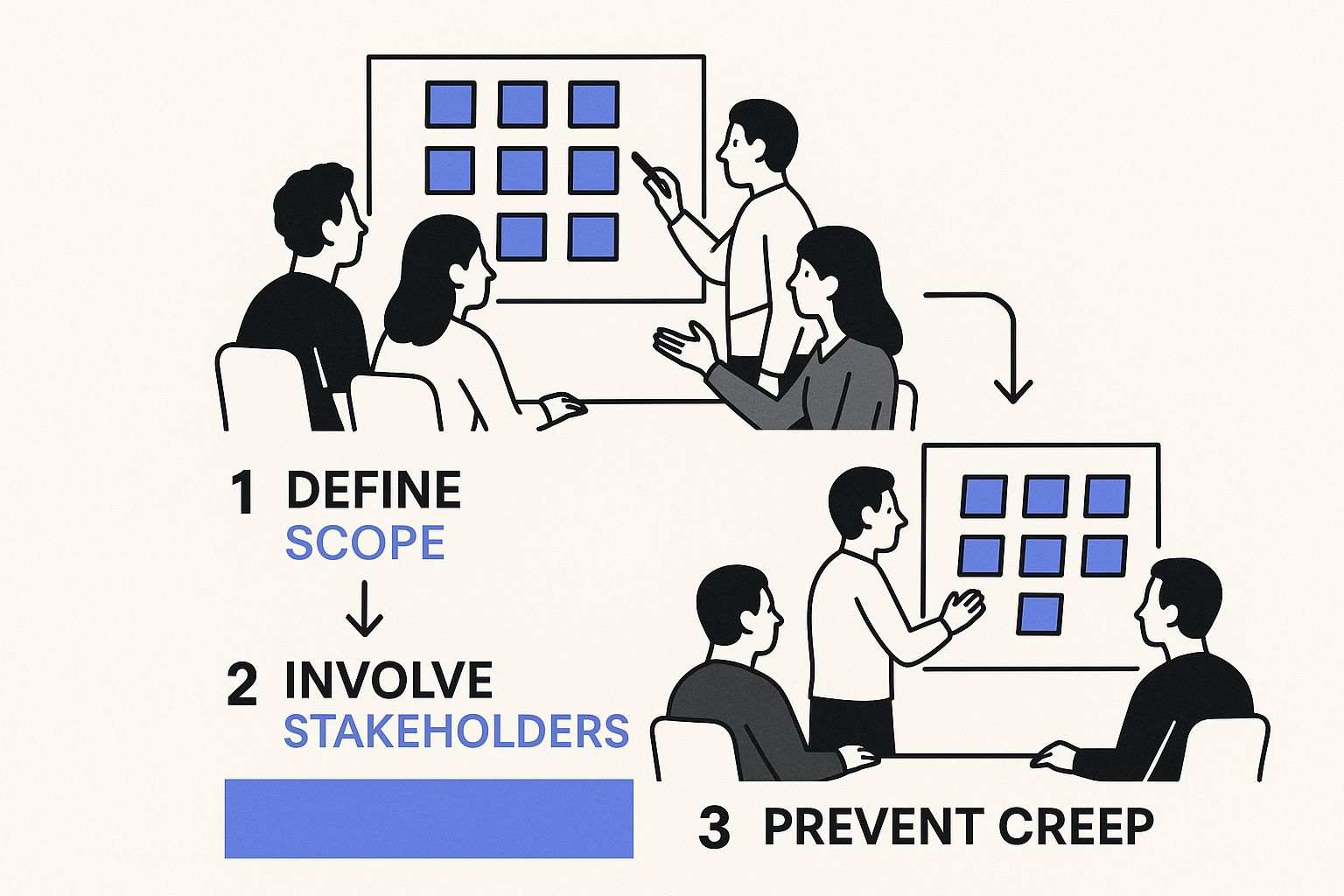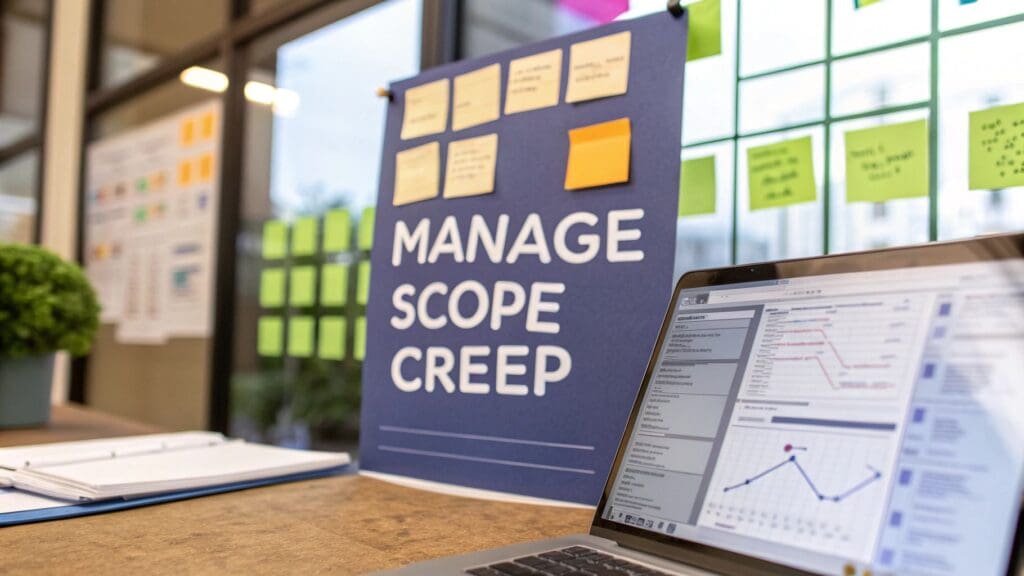Tackling project scope creep really comes down to one thing: disciplined control over what is-and isn't-part of the project. This means you need a rock-solid plan, a formal process for handling changes, and proactive communication to stop those small, unapproved additions from completely derailing your deadlines and budget.
The Reality of Scope Creep in Agency Projects

Scope creep isn't just industry jargon; it's that quiet, insidious force that slowly undermines creative and IT agency projects. It starts with a series of seemingly minor additions-a "quick tweak" here, an "easy feature" there-that just keep piling up. Before you know it, the project is over budget, behind schedule, and your team is feeling the burnout.
This problem is especially rampant in client-facing work, where evolving needs and continuous feedback are just part of the game. The creative process itself means ideas can shift and grow, but without a structured way to manage these shifts, you’re on a fast track to losing control.
Why Is Scope Creep So Common?
The struggle with scope creep is practically universal. According to a global survey from the Project Management Institute (PMI), a staggering 52% of projects are hit by it. This isn't a sign of poorly run projects; it just shows how easily uncontrolled changes can take root, even with the best intentions.
Often, the problem starts with ambiguity. When project requirements aren’t nailed down from the very beginning, it leaves the door wide open for interpretation and, eventually, unapproved changes. It's a classic pitfall in the demanding world of agency work.
For creative agencies, solid project management is the foundation of both profitability and client satisfaction. If you're looking to strengthen your operations, check out our guide on creative agency project management.
Spotting the Triggers and Your First Line of Defence
Learning to recognise the early warning signs is your best defence. Think of those small requests that bypass formal channels, vague client feedback, or an overeager team member adding unrequested "improvements"-they're all red flags. Each one might seem harmless on its own, but together, they create a perfect storm.
The most effective way to fight scope creep is to establish a shared understanding of the project's boundaries from day one. This isn't about being rigid-it's about being crystal clear.
To get ahead of the game, it helps to know what you're up against. The table below breaks down the most common drivers of scope creep in agency IT projects and the immediate actions you can take to stop them in their tracks.
Common Scope Creep Drivers and First-Line Defences
| Common Driver | Immediate Preventative Action |
|---|---|
| Vague or unclear project requirements | Develop a highly detailed Statement of Work (SOW) with specific, measurable deliverables and exclusions. |
| Informal client requests via email or calls | Implement a simple, mandatory change request form for all proposed modifications-no exceptions. |
| Lack of stakeholder involvement early on | Conduct a thorough kick-off meeting to align all key stakeholders on the project scope, timeline, and goals. |
| A team "gold plating" or adding features | Reinforce the SOW as the single source of truth and encourage the team to log new ideas for future phases. |
Having these simple, non-negotiable processes in place doesn't just protect your budget and timeline; it also sets clear expectations with your client and empowers your team to stay focused on the agreed-upon goals.
Crafting a Rock-Solid Statement of Work
Let’s be honest. Your first, and strongest, line of defence against scope creep is a meticulously detailed Statement of Work (SOW). Don't think of it as just another piece of project paperwork; it's the constitution for your entire project. It's the single source of truth that defines what you're building and, just as importantly, what you're not building.
Setting off without a detailed SOW is like sailing without a map. You'll be completely adrift the moment a client says, "Could we just add…?"
A weak SOW is full of vague promises like "develop a modern website" or "create user-friendly navigation." These phrases are just invitations for trouble and mismatched expectations. A truly solid SOW, on the other hand, is ruthlessly specific. It doesn't just state a goal; it defines success with absolute clarity, leaving zero room for assumptions.
Moving From Vague Ideas to Concrete Terms
To get this right, you have to break down every major part of the project into granular detail. This isn't about micromanagement. It's about forging a shared understanding with your client from day one. Ambiguity is the sworn enemy of on-time, on-budget project delivery.
Imagine you're building an e-commerce site for a client. A vague scope might simply say, "build product pages." A rock-solid scope, however, would specify:
- Deliverable: Design and develop product detail page templates.
- Specifics: Each page will feature a primary image, a gallery of up to five additional images, a product description, price, an 'Add to Cart' button, and a section for customer reviews.
- Exclusions: The review system will allow star ratings and text comments but will not include the ability for users to upload photos with their reviews.
This level of detail shuts down the kind of questions and loopholes that inevitably lead to scope creep down the line.
A well-defined SOW is your best tool for preventing disagreements. When a new request pops up, you and your client can refer back to the document and have a productive conversation about whether it’s a change request or part of the original plan.
Essential Components of a Bulletproof SOW
To set clear boundaries and manage expectations right from the start, a formal document like a Contract Statement of Work (SOW) Template-template) is invaluable. But remember, a template is just a starting point. You have to customise it to fit the unique reality of your project.
Make sure your SOW always includes these core elements:
- Project Objectives: What’s the actual business goal here? Don't just list tasks; explain the "why." For instance, "To increase online sales by 15% within six months of launch."
- Detailed Deliverables: A complete checklist of every single thing you will produce. This means wireframes, mock-ups, code repositories, and final launch assets. Be painfully specific.
- Clear Milestones and Timelines: Break the project into phases with firm start and end dates for each one. This helps everyone see progress and understand how different tasks depend on each other.
- Defined Exclusions: This is the part everyone overlooks, but it's the most critical for taming scope creep. Explicitly state what is not included. It could be anything from "post-launch content updates" to "third-party software integration."
By putting in the effort to create a truly comprehensive SOW, you aren't creating more red tape. You're building a foundation of trust and clarity that will protect your team, your budget, and your client relationship from start to finish.
Building a Practical Change Control Process
Let's be realistic: even with a rock-solid Statement of Work, change is going to happen on any creative or IT project. It’s just the nature of the beast. The goal isn't to build a fortress against change-it's to manage it. A practical change control process is what separates managed evolution from utter chaos, nipping scope creep in the bud before it spirals out of control.
For a fast-moving agency, this can't be some bureaucratic nightmare. It needs to be simple, clear, and-most importantly-used every single time.
The secret sauce? Document every single request, no matter how tiny it seems. This isn't about creating red tape; it's about creating a formal record that forces a crucial conversation about the impact. A client's "quick tweak" might sound harmless, but without a process, these little changes pile up and silently demolish your budget and timeline.
This is where a structured process helps your team visualise and head off these uncontrolled changes before they take hold.

This kind of visual flow highlights just how important it is to capture every request in a system. It gives you the space for proper assessment and approval, keeping the project firmly on track.
Designing a Simple Change Request Workflow
Your change control process kicks off with a dead-simple way to capture requests. You don't need a complex system; a straightforward form is often all it takes. This form is your first line of defence, ensuring every potential change is written down and weighed against the project's holy trinity: scope, time, and budget.
A cornerstone of good scope management involves setting up client feedback and approval processes. When you formalise this communication, you cut down on misunderstandings and "he said, she said" situations.
Your change request form should capture the essentials:
- A clear description of what's being asked for.
- The business reason or justification behind the change.
- Who is making the request.
- The date it was submitted.
Once submitted, the request enters a simple review workflow. A designated project lead or manager takes a look and assesses its impact. They need to answer the key questions: how does this change affect our timeline, our team's workload, and the overall cost?
From Request to Resolution
After that initial impact assessment, the change request moves to the approval stage. For minor tweaks with little to no impact, the project manager might have the authority to give it the green light. But for more significant requests, you'll need a change control board-which could be as simple as the project manager, the client, and a key team lead-to make a collective decision.
This step is absolutely critical. UK-based project performance studies show that around 85% of projects hit by scope creep blow their budgets by an average of 27%. That’s a staggering figure, and it’s why a formal process isn't just nice to have; it’s essential financial protection.
A formal process transforms a potentially difficult conversation into a collaborative decision. It shifts the discussion from "Can you do this for us?" to "Here is the impact of this change-let's decide together if it's the right move."
Communicating this to clients is all about framing. You’re not putting up barriers; you're creating a tool for transparency that protects their investment. It ensures their budget is respected and that everyone has a clear, shared understanding of the project's direction.
To get your team and stakeholders ready for these kinds of shifts, it pays to do an assessment first. We've got some great guidance on this in our article covering the 5 steps for a change readiness assessment.
Why Clear Client Communication is Your Best Defence
Most scope problems don’t start with a bad client or a sneaky request. They start with a simple communication gap. That’s it. Getting your communication right from the start isn't just about being polite; it's the foundation for preventing scope creep and turning a simple client deal into a real partnership.
The tone for the entire project gets set in that first kickoff meeting. This is more than just a round of introductions. It's your prime opportunity to walk the client through the project's roadmap, the signed-and-sealed Statement of Work (SOW), and, most importantly, your change control process. By explaining how you'll handle changes before any are even on the table, you frame it as a structured, fair system for everyone, not a bureaucratic roadblock.
Turning Clients into Scope Allies
Let's be honest: your client is a pro in their field, not necessarily in the nitty-gritty of an IT project lifecycle. A big part of your job is to gently educate them. When they genuinely grasp the knock-on effects of what seems like a "tiny tweak"-how it can blow out the timeline, stretch resources, and mess up the testing phase-they stop being a source of scope creep and become your best ally in protecting it.
Regular status updates are your secret weapon here. These shouldn't be dry, tick-box reports. Use them strategically to:
- Recap what you've just finished, tying it directly back to the SOW.
- Lay out the plan for the next sprint, again, linking it clearly to the agreed scope.
- Give a transparent, no-fluff summary of where the project stands on budget and time.
This constant, gentle reinforcement keeps the original agreement front and centre for everyone.
A well-informed client is the best defence you have against scope creep. When they understand the 'why' behind your process, they're far more likely to work with you, not against you.
Tackling Scope Creep from Inside the House
Sometimes, the call is coming from inside your own team. We’ve all seen it. "Gold plating" is the classic term for when your own designers or developers add unrequested features, usually with the best intentions of delighting the client. The motive is great, but the outcome is the same: the scope gets warped without any formal approval, burning through your budget and pushing back the delivery date.
Dealing with this requires a culture of discipline. You need to reinforce that the SOW is the project's bible. It’s the single source of truth. Encourage your team's amazing ideas, but give them a proper home. A simple "ideas backlog" is perfect for this. Team members can park their suggestions for new features or cool enhancements there.
This approach pays off in several ways:
- It shows you value the team's input without letting them derail the current project.
- It keeps everyone focused on delivering exactly what was promised, on time and on budget.
- It builds a pipeline of future work. You can present these fleshed-out ideas to the client later as smart, phase-two upgrades.
By mastering proactive communication-both with your client and your own team- you create an environment where the project's boundaries are understood and respected by everyone. It makes the entire process smoother and a lot less stressful.
How to Spot and Respond to Early Warning Signs

Even with the most detailed project plan, scope creep has a way of sneaking in. The real trick to managing it is learning to catch the subtle, early warning signs before they snowball. These don't usually arrive as formal requests but as casual remarks dropped in conversations or emails.
These phrases are classic red flags. They signal that what feels like a small favour is actually an unapproved change to the project scope.
Common Warning Phrases and How to Respond
Certain phrases should set your alarm bells ringing. They often sound innocent, but they're a gateway to uncontrolled changes.
- "While you're in there…" This is the classic opener for adding an unplanned task.
- Your Response: "That's an interesting idea. Let's get it logged as a change request so we can properly assess its impact on the timeline and budget. That way, we can make an informed decision together."
- "This should be easy…" A phrase that almost always dismisses the true effort required.
- Your Response: "I appreciate you thinking it's straightforward. To be sure, let's run it through our change process to confirm the work involved and check for any unexpected knock-on effects."
By funnelling these requests back into your formal process, you aren't being difficult-you're being diligent. It protects the project's integrity and shifts a casual comment into a structured, professional conversation about priorities and resources. This is a core skill in the broader discipline of project risk management. If you want to sharpen these abilities, you can master the risk management lifecycle for project success with our detailed guide.
The Downstream Effects of Unchecked Changes
Letting these "small" additions slide has consequences that go way beyond the budget. In the UK's built environment sector, uncontrolled changes are a primary driver of project delays and financial pressure. This constant need to absorb more work often leads to team burnout, a drop in morale, and a noticeable dip in the quality of the final output.
When your team is overworked and morale is low, mistakes happen. Deadlines get missed not because the team is incapable, but because they're stretched thin chasing moving goalposts. The high-quality, creative work you promised the client inevitably suffers.
Understanding these damaging effects is your best tool for advocacy. When you push back against a seemingly small change, you aren't just protecting the budget-you are protecting your team's well-being and the final quality of the project.
This mindset gives you the confidence to address scope creep head-on. You gain the language to explain why sticking to the process is vital for everyone's success, safeguarding your team, your client relationship, and the project itself.
Answering Your Questions About Scope Creep
Even with the best-laid plans, scope creep will inevitably throw some tricky situations your way. Knowing how to handle them confidently is key. When you and your team can anticipate the common questions, you can respond consistently and keep the project on track.
Here’s a look at some of the most frequent challenges that pop up in an agency setting and how to navigate them.
How Do I Introduce a Change Process to a Long-Standing Client?
This can feel awkward, especially with a client who's used to making casual requests over email or a quick phone call. The secret is to frame it positively right from the start, ideally during the project kick-off meeting before any changes are even on the table.
Position the change process as a tool that protects their investment and guarantees total transparency. You're not adding red tape; you're creating a system that helps you both track every idea and accurately assess its impact on the timeline and budget. This prevents any nasty surprises down the line.
Try saying something like: "To make sure every great idea is captured and properly evaluated, we'll use a quick change request form." This presents the process as a mutual benefit-a path to success, not a bureaucratic roadblock.
What Is the Real Difference Between Scope Creep and Necessary Changes?
The defining line between the two comes down to one word: control.
A necessary project change is one that's been formally identified, discussed, and approved through your change control process. Its full impact on the project's budget, resources, and timeline is understood and agreed upon by everyone. It’s a conscious, documented decision.
Scope creep, on the other hand, is the sneaky stuff. It's the uncontrolled, undocumented additions slipped into the project informally. These changes happen without any formal assessment, leading to budget blowouts and missed deadlines that were never part of the original deal.
How Do I Manage Internal Scope Creep from My Own Team?
Ah, the classic "gold plating" issue. This happens when your team, with the best of intentions, adds extra features to impress a client. While it comes from a good place, it's a dangerous form of scope creep that can derail a project just as easily as client-driven changes.
Reinforce the Statement of Work (SOW) as the single source of truth. Make it clear to your team that adding unrequested features can throw the schedule off, eat into the budget, and even introduce elements the client never actually wanted.
A great way to handle this is by creating a dedicated 'ideas list' or 'feature backlog'. Team members can log their innovative suggestions there. These ideas can then be formally presented to the client as potential enhancements for a future phase, turning good intentions into a new business opportunity instead of a current project risk.
What If a Key Client Insists on a Change but Sidesteps the Process?
This is where you need a bit of diplomacy. The first step is to acknowledge the importance of their request and their value as a client. This immediately shows you're listening and are responsive.
Verbally confirm the change and your intention to act on it. Then, and this is the crucial part, immediately follow up in writing-usually with an email. In that message, state your understanding of the request and its likely impact, even if it's just a high-level estimate for now.
For example: "Following our chat, we'll get started on adding X feature. Our initial assessment suggests this will likely add Y days and Z cost. We'll prioritise this for you and follow up with a formal change order to get this documented for our records."
This approach allows you to be agile and responsive to a key stakeholder while still creating a paper trail and gently nudging them back towards the process you both agreed on.
At InfraZen Ltd, we specialise in creating stable, secure, and efficient IT environments so your creative agency can focus on what it does best. We manage the technical complexity behind the scenes, eliminating disruptions and protecting your valuable work. Learn how we can support your agency's success.

